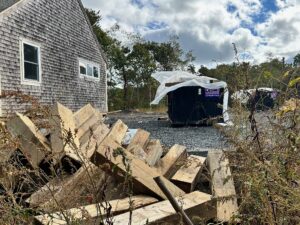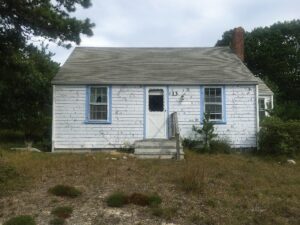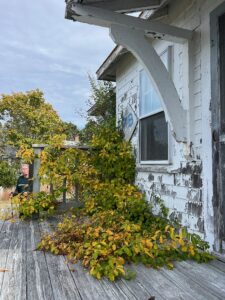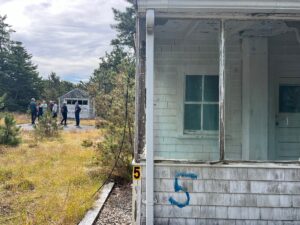TRURO — Cape Cod Builders Inc., the Bourne company hired by the town to renovate a cottage for employee housing, instead demolished it sometime over the weekend of Oct. 5-6 without consulting local officials or the town’s engineers.

The demolition of the 84-year-old house known as cottage 13 that had been part of a cottage colony on the Walsh property put an abrupt end to a long process that included a move costing $75,500 last February to a town-owned lot at 25 South Highland Road.
Since that move, the interior had been gutted down to the studs, and plans were in the works to lift the house onto a new foundation. When renovation was complete, the plan was for that house and a second one, donated to the town and moved to the same lot from South Pamet Road, to be rented to seasonal workers or municipal staff.
Cape Cod Builders’ contract included the installation of foundations and a septic system for both buildings, but the renovation work was to be on the Walsh cottage only. According to DPW Director Jarrod Cabral, Cape Cod Builders has been paid $449,000 to date. The balance of the contract came to $712,684, Cabral said in an email.
Cabral and Town Manager Darrin Tangeman are expected to update the select board at 11 a.m. on Oct. 17 during a meeting called to determine how to address the unauthorized demolition.
Cabral told the select board about the demolition at its Oct. 8 meeting, saying he had learned of it the day before. He immediately went to 25 South Highland Road. “I was shocked to see what I saw there,” he said.
Town staff and Weston & Sampson consultants then met with Cape Cod Builders. “Noting rot, mold, and other framing deficiencies, they thought that demolishing the building was the safest thing to do,” Cabral said.
The town is now looking to get the contractors’ “proposed commitments to the town in writing on what they want to do to remedy the situation,” said the DPW director.
All the work associated with the move and renovation of the Walsh cottage was being paid for by a $900,000 grant from the state under the MassDevelopment Underutilized Properties program, Cabral said. The effect of the demolition on the grant is not yet known.
Meanwhile the town is scrambling.
In a press release issued late last week, Tangeman said his staff is working with the building commissioner on the preparation of a new or amended building permit and with town counsel on possible legal recourse.

“Additionally, staff is considering alternatives to the renovation, such as installing a prefabricated accessory dwelling unit (ADU) in place of the Walsh cottage,” said Tangeman in the press release. “These considerations will be discussed with the grant team at MassDevelopment to ensure that the project will continue to be an eligible use of funds.”
The debris from the demolition of the Walsh cottage was placed in four large dumpsters covered in plastic. The material will be shipped to a facility permitted by the Dept. of Environmental Protection. The DPW found no asbestos insulation in the walls or on pipes, the town manager said, and no lead lining in the chimneys. The dumpsters will be tarped, he said, but “none of the material in containers at 25 South Highland is presently hazardous.”
Michael Rorro, a neighbor and opponent of the employee housing proposal, said that because the paint on the house probably dates to the 1940s, its makeup should be considered. “All the paint back then was lead-based, and who knows how many layers there were.”

Neither Chase Pappas, listed in the state’s corporation database as Cape Cod Builders president, nor Thomas Pappas, listed as the company’s vice president, returned calls or responded to an email seeking comment on the demolition.
Select board chair Susan Areson said she had reviewed the town’s contract with Cape Cod Builders but that any discussion of legal steps would have to be done in a closed session. She added that each member of the board was invited to submit questions to the town manager about the demolition and what happens next.
Other Walsh Cottages Can Go
Just days before the unauthorized demolition of cottage 13, the historical commission unanimously voted on Oct. 1 to allow the demolition of the seven cottages that remain on Walsh Way.

Historical commission chair Matthew Kiefer described the cottage colony as both “pretty ordinary” and “in rough shape.” A 1920s bungalow might be worth preserving, Kiefer said. But “these do not meet the highest level of significance among the historic resources of the town.”
Truro’s demolition delay bylaw includes criteria for determining whether it’s worth preventing the demolition of a building for one year so that alternatives can be pursued. A building’s distinctive architectural style is one possible reason for a delay; another can be that the building is tied to historic events or that its past owners played a significant role in local history.
The commission asked whether offering the cottages to those willing to relocate them was a viable alternative to demolition. Cabral said that would require a long and complicated process, involving hiring a consultant to develop a traffic management plan, securing permission from the Dept. of Transportation, hiring a moving company, and coordinating with utility companies so that transmission lines could be lowered during the move. Such moves would likely take seven or eight months and cost a great deal of money, Cabral said. “I wouldn’t recommend it to anybody,” he said.

Commission vice chair Chuck Steinman noted that the town had already given “fairly extensive consideration” to the cottages. “I think that if we institute demolition delay, it will only increase the cost to the town,” Steinman said.
Some commissioners had questions about future plans for housing on the Walsh property, a topic that was long debated by one planning committee that was disbanded in 2023 and will soon be taken up by a second planning committee.
According to Truro Planner and Land Use Counsel Barbara Carboni, it has now been established that no more than 160 housing units will be built there. Construction will be done in phases with no more than 80 units built in the first phase.
Commissioner Richard Larkin asked for a breakdown regarding housing types, but Carboni said it has not yet been decided. “It’s going to take a little while to sort out what happens on that site,” she said.



